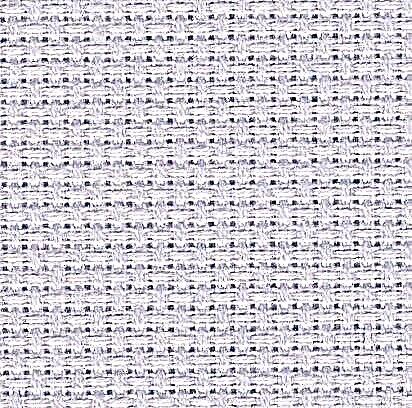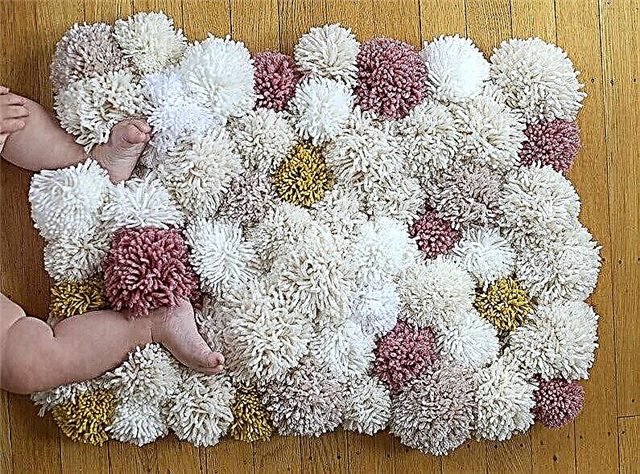"Aida" or "uniform", plastic and soluble, stramin and patch ... How to choose the canvas for embroidery and calculate the right amount of fabric for work - we understand our review.
What happens canvas: basic types
1. Canvas type "Aida"

Photo: cloudsfactory.net

Photo: wisegeek.com
The most famous and popular variety. In a canvas of this type, the threads are intertwined in a special way, so as to form small squares with holes in the corners that are convenient for a needle to hit into them (while it’s more difficult to stick a needle into the dense center of the square, this helps to avoid mistakes). This canvas is very convenient for cross-stitching, including for those who are just starting to learn this needlework.
2. Canvas of uniform weaving, or "uniformity"

Photo: cloudsfactory.net

Photo: posiegetscozy.com
In the canvas of uniform weaving, the threads are interlaced in the classical way, but not too tightly so that it is more convenient to count the crosses and fall between the threads with a needle. The “uniform” canvas is more often chosen by more experienced embroiderers: working with it requires more experience and a trained eye. Here you have to “cross” the crosses yourself (as a rule, these are 2 by 2 threads in length and width). But the result is more “lively” and realistic - especially if you use a shallow canvas, embroidering a large pattern.
3. Stramin

Photo: leutenegger.com.au

Photo: youtube.com/D. K. Wright Construction
Stramin is a canvas characterized by increased rigidity. Stramin looks like a hard and sparse filament grid. Most often used to create carpets and tapestries. Sometimes due to the rigid structure it can be used for the manufacture of boxes or bags. More often, the size of the stramin’s cross is larger than that of the other canvas, so they are embroidered on it with thicker threads (wool, acrylic). A hoop or a machine is not needed here, the stramin keeps its shape by itself. Masters advise: so that during operation the threads do not cling to the hard edges of the stramina, it is worth tying them with a thick thick soft thread or gluing them with masking tape.
4. Plastic canvas

Photo: viorin.com

Photo: gingerbreadsnowflakes.com

Photo: pinterest.co.uk/sdooley13
This canvas looks like a rare plastic mesh and is distinguished by the fact that it holds the given shape well. It is a plastic canvas that is good to use for bulk or textured embroidery, for the manufacture of souvenirs of various shapes. When cropping the edges of such a canvas will not crumble - so you can embroider and cut out any figures (remembering the perfect wrong side of the work). Also, such a canvas is used for the manufacture of boxes, bags and so on (sometimes it is sold already in the form specially set for the manufacture of a particular product).
5. Laid on canvas

Photo: weelittlestitchescrossstitch.blogspot.com
This canvas is created in order to embroider even crosses on any fabric you need. Such a canvas is superimposed on a fabric; After the pattern is embroidered, the canvas is gently pulled out one thread at a time, while the embroidery remains intact. With such a canvas it is convenient to decorate different products with embroidery elements.
6. Soluble canvas

Photo: essorille.livejournal.com
Invented not so long ago to replace the invoice pull-out canvas. Just like the previous version, such a canvas is applied to the fabric, embroidery is done with it, and after the finished work is soaked in warm water. Water dissolves the canvas, and it disappears, and the pattern remains on the product.
Hand sewing needles: main types and purpose
What is the canvas count

Photo: youtube.com/Carolyn Mazzeo
Canvas count is its important characteristic, which expresses the size of the “cell” of the canvas in numerical value. This characteristic is important because the size of each cross of your embroidery will depend on the value of the counter, respectively - the thickness of the thread, which is better to embroider, and in the end - the size of the finished work.
The count is determined, as a rule, by the letters ST and the numbers before or after the letters. The dependence of the size of the cross on the value of the count is the opposite: that is, the larger the number of count, the less cross you get on this canvas. For example: a canvas with a count of 9 will give crosses larger than a canvas with a count of 11. The size of the canvas can be different and is characterized by the number of cells in 1 inch.

Photo: thesprucecrafts.com
Hoops of different types: which to choose, how to use?
Cheat sheet: how many crosses in the canvas of different counts
Canvas County "Aida": the number of crosses in 10 cm
9 = 33 crosses
11 = 43 crosses
14 = 55 crosses
16 = 63 crosses
18 = 71 cross
“Canvas” canvas count: “number of crosses (2 by 2 threads) per 10 cm
20 = 40 crosses
25 = 50 crosses
28 = 55 stitches
32 = 63 crosses
36 = 71 cross



